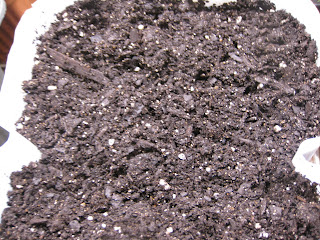Recently I wanted to make something spicy for dinner. After making it, I came to the realization that the hot pepper flakes and store bought hot sauce just weren't cutting it. So, today I'm going to plant two different types of hot pepper, Cayenne and Habanero, with the goal of making my own hot sauce from seed to bottle. Lets get started.
The first thing to do is to pick up your pepper seeds if you don't already have some, get out the potting soil, and to fill a vessel of some sort with the soil. In this case, I'm using the bottom of a water container, into which I've punched 6 holes for drainage. When filling your container with soil, make sure you break up any large chunks and make sure you don't compress the soil. You want the soil to be very loose to ensure that your seedlings won't have to struggle to grow.



Now, use your finger to establish rows in which to put your seeds. These should be no deeper than one half of an inch for most plant seeds. Once you've made all your rows, remove the number of seeds you'd like to plant from its package and place them into one of the rows you've just created. In this case, a 2 inch spacing between seeds is being used to prevent over crowding of the seedlings. Once in place. use your fingers to gently push some soil from either side of the rows to cover up the seeds. Be sure not to apply downward pressure over the seeds as this will compact the soil, making it harder for the seedlings to push through.







At this point, all thats left to do is to label the rows you've just planted and to water them. Now, while you don't want to drench your seedlings on a daily basis, you want to give them plently of water, bordering on over watering them, right after planting. This is done for two reasons. One, is to shock the seeds into growth, and two, to add moisture to the new, often very dry, soil that is in the planter.
So there you have it, you've just planted some new peppers. Ensure your seedlings receive plenty of light, fluorescent in this case, and keep the soil moist. In a few weeks we'll have a few small seedlings pushing through, and in a few months we'll have peppers growing. I'll keep you up to date with the peppers as they develop and mature. If all of the seeds sprout, they will have to be transplanted into separate larger containers to give them ample room to grow, but we'll tackle that when the time comes. Now, get out there and grow some of your own.